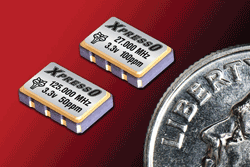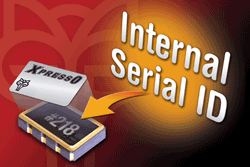New oscillator technologies enhance wireless/portable apps
Today’s oscillators not only fulfill the basic performance requirements, but also a variety of packaging footprints
BY ROGERS BURNS
Fox Electronics
Fort Myers, FL
http://www.foxonline.com
Over the past few years, trends in wireless/portable applications have gone through several evolutions. Each day, new advances are being made in an effort to bring together the wants and needs of both electronics manufacturers and designers of wireless/portable electronics equipment.
Manufacturers want reliable components that are more affordable and delivered with shorter lead times, and designers covet the need for components to be as small as possible, while using the least amount of power and providing continual operation. In the end, both are looking to reach a common goal — providing consumers the very best product on the market.
The best offense is a good defense: Traceability is key
As consumer demand for high-tech products is on the rise, so is the quality control process to avoid producing faulty components used in items such as GPS systems, wireless computers and portable defibrillators to name a few. One recent method for tracking component usability and function is serial identification (ID). As an example, Fox Electronics has designed a patented process into the manufacture of its XpressO oscillator series to ensure quality control through lot traceability at a level previously unattainable in the frequency control industry.
A unique serial ID, internally assigned to each oscillator, enables quick, accurate tracing of any oscillator back to its original manufacturing process, including raw materials used, date of manufacture, electrical testing performed, and equipment used to manufacture the specific part (see Fig. 1 ). This comprehensive set of data gives users a higher degree of confidence that problems can be traced and corrected immediately, decreasing the risk and exposure to faulty products.

Fig. 1. One recent method for tracking component usability and function is serial identification (ID).
In the case of Fox, if a component should ever fail, the faulty part is sent to one of the company’s worldwide locations where the lot identification and serial number are read and valuable information is obtained about the individual part immediately. The result: quick, reliable knowledge as to the extent of the defect; is an entire batch of parts bad or is the defective part an anomaly?
Less current/tiny parts
The fundamental objectives for increasing the useful operating time of handheld electronic devices are maximizing battery efficiency, minimizing energy consumption or—ideally—both. Reducing a component’s power draw prolongs the uninterrupted use of a handheld unit in the field before it needs to have its batteries recharged or replaced.
The availability of new dies and developing technologies has reduced current requirements to as little as 2.5 mA for frequencies below 32 MHz, versus 15 mA from just a few short years ago. For low-current fixed-frequency oscillators, every milliampere counts. These energy-saving designs have an output load rating of 15 pF, and can drive up to three application-specific integrated circuits (ASICs). But of course, the lighter the load, the less current the device draws, so for applications using only one ASIC, the oscillator’s actual load is typically around 5 pF during normal operation, further prolonging battery life.
Another condition that affects energy and power is the frequency at which the device is in use, and the higher the oscillator’s frequency, the greater the energy requirement. Not only does a low-current oscillator use proportionally less energy, but the incremental rise in terms of actual energy consumption is much lower over the same frequency range for a 2.5-mA oscillator than it is for a 15-mA oscillator. For example, at 50 MHz, the low-current oscillator is at only 3.5 mA and the traditional oscillator is at 20 mA. The low-current oscillator increases power consumption by only 1 mA, while the traditional increases by 5 mA at the higher frequency of 50 MHz.
Reducing phase-noise and ensuring frequency stability are two more aspects that have radically improved wireless/portable unit performance in recent years. Oscillators employ noise reducing technology and low noise architecture, offering significantly low levels of jitter and phase noise. Because excessive noise can result in lost packets and missed information during wireless data transfer, this technology is essential.
Standard low-current fixed-frequency oscillators are now available with frequency stability ratings from 100 ppm down to 25 ppm at operating temperatures between 40° and 85°C, and as low as 20 ppm at operating temperatures between 10° and 70°C. Wireless LANs and similar systems require stabilities as accurate as 20 ppm to ensure synchronization. If the oscillator drifts more than that, the unit can “lose lock,” resulting in lost packets and missed information during data transfer.
Space-saving concerns are of the utmost importance when considering handheld units. Today, there are a variety of very affordable oscillator solutions not only fulfilling the basic performance requirements low current, low noise, and frequency stability but also a variety of packaging footprints that range from 7 x 5 mm down to the miniature 3.2 x 2.5-mm size (see Fig. 2 ).

Fig. 2. Today, there are a variety of very affordable oscillator solutions not only fulfilling the basic performance requirements, but also a variety of packaging footprints.
With innovation comes flexibility
With the introduction of configurable oscillator technology featuring ASICs for accurate performance and improved noise characteristics, engineers and purchasing personnel alike have benefited from increased design flexibility and custom specification ranges combined with decreased component costs and delivery time. An increasing number of wireless applications are employing these advanced oscillator technologies and low current may not always be as high a consideration.
For line-powered applications, where current is a lesser issue, configurable oscillator technology offers system designers creative options for controlling component costs and lead times without compromising performance. This generates time-saving, cost-effective alternatives for applications such as base-station access points for wireless data collection networks, traffic-management on central computers and Ethernet timing functions.
The range of choices now available for oscillators enables system designers to build the ideal style and frequency for individual applications. Designers can specify custom frequencies from 0.75 to 250 MHz in HCMOS and 0.75 to 1.35 GHz in LVDS and LVPECL versions for both crystal oscillators (XOs) and voltage-controlled crystal oscillators (VCXOs). With frequency stability as tight as 20 ppm.
ASICs incorporated into the oscillators enable accurate performance, decreased cost and increased flexibility by employing proprietary third-order DSM noise reducing technology and low noise architecture that offers noise levels comparable to bulk quartz and SAW oscillators.
It’s as easy as 1,2,3
With the advances in noise-reducing technologies, the continually growing ranges of specifications and the multitude of options available in oscillators today, finding the right oscillator is as easy as one, two, three. First, determine what frequency, stability and noise characteristics are important to you. Second, think about how important error rates, traceability and budget are to you and your business. Third, decide whether delivery and lead times are crucial to your design. Once you have answered each of these questions, finding the oscillator technology that is right for your application should be simple. ■
Advertisement
Learn more about Fox Electronics





